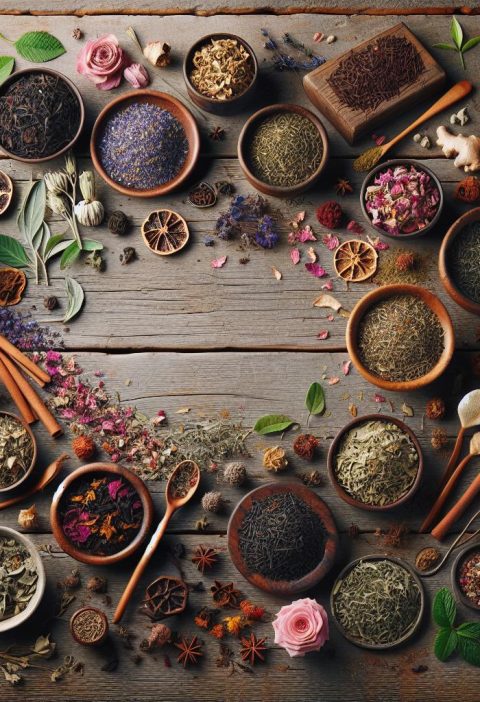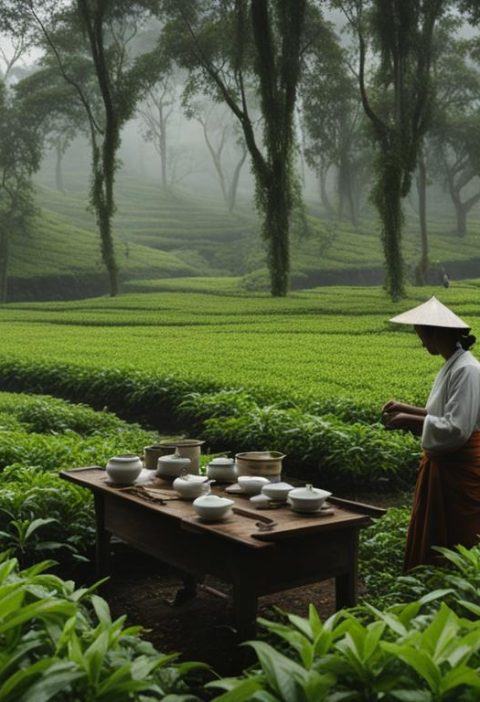Tea isn’t just a beverage; it’s a ritual, a journey that takes us through different flavors, aromas, and cultures. In our quest for a deeper tea experience, we delve into the world of tea rituals. These rituals are not just about brewing a cup of tea but about savoring every sip mindfully, unlocking the true essence of the leaves.
From the serene Japanese tea ceremony to the vibrant Indian chai-making process, tea rituals offer us a unique way to connect with the beverage on a spiritual level. As we explore these age-old practices, we learn to appreciate the nuances of tea brewing, the significance of water temperature, and the art of steeping. Join us on this enlightening journey as we uncover the secrets of tea rituals for a richer and more fulfilling tea-drinking experience.
The Art of Tea Brewing
When it comes to the art of tea brewing, precision and mindfulness are key. Whether you’re a novice or a seasoned tea enthusiast, honing your brewing skills can elevate your tea-drinking experience to new heights. Let’s delve into different levels to enhance your brewing techniques:
For Novices: Getting Started with the Basics
- Choose the Right Tea: Start with loose leaf or quality tea bags for a flavorful brew.
- Water Temperature: Boil water and let it sit for a minute before pouring over delicate teas like green or white.
- Steeping Time: Follow the guidelines on the tea packaging for the optimal flavor.
- Experiment: Try different teas, water temperatures, and steeping times to find your preferred taste.
For Intermediate Enthusiasts: Elevating Your Brew
- Teaware Upgrade: Consider investing in a tea kettle, infusers, or gaiwan for a more authentic experience.
- Water Quality: Opt for filtered or spring water to avoid any unwanted flavors in your brew.
- Multiple Infusions: Certain teas like oolong or pu-erh can be steeped multiple times, bringing out different flavors.
- Mindful Brewing: Focus on the process, from the sound of boiling water to the aroma rising from your cup.
- Gongfu Cha Method: Embrace the Chinese Gongfu Cha ceremony for intricate brewing rituals and concentrated flavors.
- Tea Pairing: Explore the world of tea and food pairings to enhance both culinary experiences.
- Temperature Precision: Invest in a temperature-controlled kettle for precise brewing conditions.
- Origin Exploration: Delve into single-origin teas to appreciate the nuances of terroir and craftsmanship.
From selecting the perfect tea to mastering the complexities of steeping, brewing tea is an art form that evolves with practice and passion. Let’s continue our tea journey with a deeper understanding and appreciation for the flavors that each cup brings.
The Serenity of the Japanese Tea Ceremony

The Japanese Tea Ceremony, also known as Chanoyu or Chado, is a traditional ritual that embodies harmony, respect, purity, and tranquility. This centuries-old practice focuses on the preparation and presentation of matcha, a powdered green tea known for its vibrant color and earthy flavor.
For Beginners: Embracing the Basics
- Start by learning about the essential tools used in the ceremony, such as the chawan (tea bowl), chasen (tea whisk), and chashaku (tea scoop).
- Practice proper etiquette, including bowing when receiving and serving tea, holding the bowl with both hands, and enjoying each sip mindfully.
- Follow a basic step-by-step guide to prepare your first bowl of matcha, ensuring the right consistency and frothiness.
For Intermediate Enthusiasts: Deepening Your Practice
- Explore the significance of the four principles of Chanoyu: harmony, respect, purity, and tranquility, and incorporate them into your tea preparation.
- Invest in high-quality matcha powder from reputable sources to elevate the flavor and aroma of your tea.
- Experiment with different whisking techniques to achieve the perfect froth and consistency in your matcha.
- Dive into the history and philosophy behind the Japanese Tea Ceremony to gain a deeper understanding of its cultural significance.
- Consider participating in a temae, a formal tea gathering, to experience the ceremony in its traditional setting.
- Explore tea ceremony schools or workshops to refine your skills and learn advanced techniques, such as kaiseki (a traditional Japanese multi-course meal) pairing with tea.
Remember, the Japanese Tea Ceremony is not just about preparing tea; it’s a profound experience that fosters mindfulness, connection, and appreciation for the beauty in simplicity. So, let’s embrace the serenity of this ancient ritual and savor the moment with each delicate sip of matcha.
Unlocking the Aromas: Importance of Water Temperature
When delving into the realm of tea rituals for a richer flavor experience, one key element often overlooked by many enthusiasts is the importance of water temperature. This factor plays a crucial role in the overall taste and aroma of your tea, significantly impacting the brewing process.
For Beginners: Mastering the Basics:
- Start by heating water to the appropriate temperature based on the type of tea you are preparing.
- For delicate teas such as green tea, aim for a lower temperature around 160-180°F to avoid bitterness.
- Black teas and herbal blends, on the other hand, benefit from higher temperatures of 200-212°F for a full extraction of flavors.
For Intermediate Tea Connoisseurs: Enhancing Your Brew
- Experiment with different water temperatures within the recommended range to discover how it alters the profile of your tea.
- Consider investing in a temperature-controlled kettle for precise brewing control, ensuring consistent results.
- Recognize that slight variations in temperature can lead to subtle nuances in taste, allowing you to tailor your brew to perfection.
- Fine-tune your brewing skills by exploring the impact of water temperature fluctuations during the steeping process.
- Embrace traditional methods such as kyusu (Japanese teapot) brewing, which adapts water temperature adjustments to elevate the tea experience.
- Engage in sensorial analysis to discern the intricate interplay between water temperature and tea leaves, unlocking a deeper understanding of flavor extraction.
By honing our awareness of the significance of water temperature in tea brewing, we open doors to a sensorial journey filled with nuanced aromas and refined flavors. Whether you’re at the beginning of your tea exploration or a seasoned connoisseur, mastering this fundamental aspect will undoubtedly enhance your overall tea ritual experience.
Savoring Each Sip: Mindful Tea Drinking
For Beginners: Embracing the Tea Ritual
- Start by choosing a tea that appeals to you, such as green tea or black tea.
- Invest in a temperature-controlled kettle to ensure the water is just right for your chosen tea.
- Follow brewing guidelines carefully to uncover the full spectrum of flavors in your tea.
- Begin with shorter steeping times and gradually adjust to suit your taste preferences.
For Intermediate Enthusiasts: Exploring Tea Varieties
- Experiment with different tea types and water temperatures to tailor your brewing experience.
- Consider using a traditional kyusu teapot for a more authentic brewing process.
- Dive deeper into the world of tea by sampling oolong, white, or herbal blends.
- Take note of subtle flavor variations with temperature fluctuations during steeping.
For Experts: Mastering the Art of Tea Brewing
- Fine-tune your brewing skills by understanding the nuances of water temperature and steeping times for specific teas.
- Source high-quality teas from reputable suppliers to elevate your tea-drinking experience.
- Explore gongfu cha or Japanese tea ceremonies for a deeper connection to the tea ritual.
- Share your knowledge and passion for tea with others to enrich the tea community.
- Remember, the key to a satisfying tea ritual lies in attention to detail and exploration.
- Whether you’re a beginner or an expert, the joy of tea drinking is in the journey of discovery.
- Stay curious, keep experimenting, and savor each sip to unlock the full potential of your tea experience.
| Temperature | Type of Tea |
|---|---|
| 160-180°F | Green Tea |
| 200-212°F | Black Tea, Herbal Tea |
We’re here to guide you on your tea-drinking voyage, from the initial steep to the last drop in your cup.
Conclusion
In mastering the art of tea rituals, we embark on a journey of discovery, from selecting our favorite teas to exploring different brewing methods. Attention to detail and the willingness to experiment are key to enhancing our tea-drinking experience. Whether we’re beginners, intermediates, or experts, there’s always room to deepen our understanding of tea flavors and elevate our enjoyment. By investing in quality teas, equipment, and engaging in tea ceremonies, we enrich our connection with this ancient beverage. Let’s continue to savor each sip, appreciating the nuances and complexities that tea rituals offer us. Cheers to a more flavorful and fulfilling tea journey ahead!






